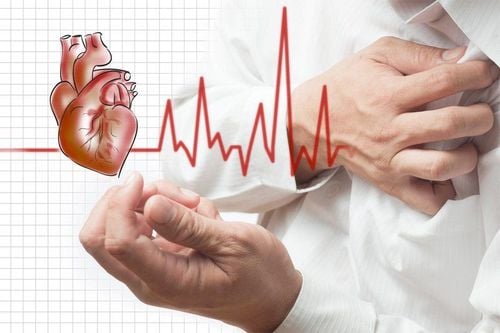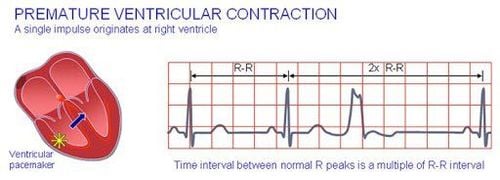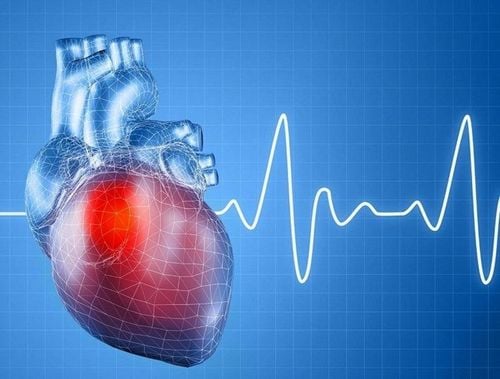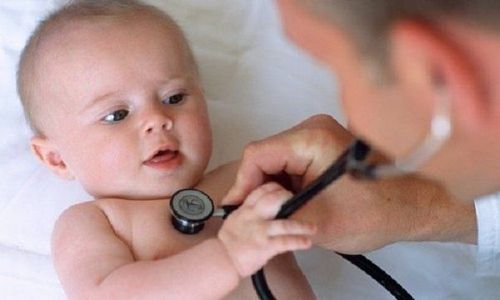This is an automatically translated article.
The article was written by Specialist Doctor II Nguyen Bang Phong - Cardiovascular Center - Vinmec Times City International General Hospital
The term concussion (Latin: Commotio cordis) refers to a sudden cardiac arrest that occurs after an impact on the chest wall without causing structural damage to the heart. This phenomenon is mentioned quite early in European literature from the 1700s when a number of healthy athletes suddenly died after a collision during competition.
Concussion is the second leading cause of sudden death in athletes, after hypertrophic cardiomyopathy, but differs in that sudden cardiac death occurs in a structurally normal heart. .
1. Epidemiology
In the mid-1990s, the United States established a program to register concussions (National Commotio Cordis Registry (NCCR). About 200 cases have been recorded so far. Here are some notable figures from this program.
The age of concussion is very young, the average is 15. Only 9% of concussion cases are over 25 years old. 95% are male. 75% are athletes, mostly professional athletes, only 25% are amateurs. Most cases are caused by hard balls shot to the chest such as baseballs, lacrosse balls, hockey balls or body collisions such as in football or football. The NCCR also received reports of 60 cases outside of the United States, and the analysis found that the average age of concussion patients outside the United States was higher: 19 versus 15.
2. Mechanism of cardiac arrest in concussion
Ventricular fibrillation occurs after a sufficiently strong, rapid, direct impact on the chest wall in the anterior region of the heart, with or without damage to the chest wall, but without damage to the structure of the heart.
Ventricular fibrillation is caused by a shock force that causes a sudden increase in intracardiac pressure, activating the potassium channel at the right time of electrical vulnerability during the repolarization phase (T wave on the electrocardiogram).
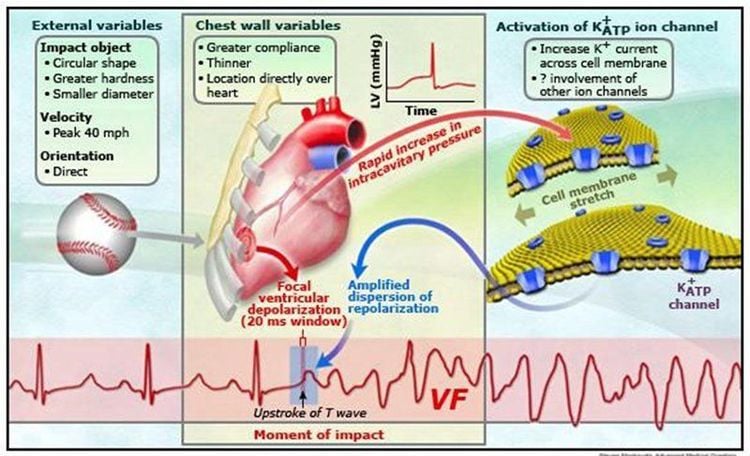
* Experimental studies show that several factors influence this mechanism:
Timing of impact: This is the most important contributing factor to ventricular fibrillation in concussion. Only shocks occurring between 20 and 40 ms on the ascending edge of the T wave on the electrocardiogram cause ventricular fibrillation, because this is the period of early repolarization, which is electrically most vulnerable. Site of impact: Only direct chest wall collisions cause ventricular fibrillation. Impact velocity: In the range less than 40 mph (equivalent to 65 km/h), the faster the speed of the impacting object, the more likely it is to cause ventricular fibrillation. But if the impact speed is 40 mph or more, the likelihood of causing ventricular fibrillation will decrease, conversely, myocardial concussion will increase. The higher the hardness of the impact object, the greater the possibility of causing ventricular fibrillation. Shape of impactor: Flat-shaped collision objects do not cause ventricular fibrillation, in contrast, spherical, small-area objects have a high probability of causing ventricular fibrillation. *Experimental studies have failed to provide evidence to explain why concussion occurs mainly in very young people. There are two factors that can explain this: the first is the large number of very young people participating in ball sports and the second is that in adolescence the chest wall is still thin and not strong enough to protect the heart. from collisions.
3. Clinical presentation and diagnosis
Solid balls such as baseball, lacrosse, and hockey are more likely to cause concussion than air balls like football, rugby, volleyball, and basketball.
In addition to ball impact, physical contact during competition in all contact sports can cause concussion.

There are 2 situations that happen: The first is sudden death during practice or competition. The second situation is the loss of consciousness during practice or competition, the electrocardiogram at that time recorded ventricular fibrillation.
With the first scenario, if the post-mortem autopsy showed no abnormalities in the heart and coronary arteries, it would be diagnosed as sudden cardiac death. With the second situation after regaining consciousness, the patient will have a deep cardiovascular examination: 24-hour electrocardiogram, electrophysiological probe, echocardiogram, cardiac magnetic resonance, coronary angiography to rule out diseases Structural heart disease, coronary artery disease and potential arrhythmic factors such as Brugada syndrome, long QT syndrome, catecholamine-induced ventricular arrhythmias. Only after the results of the above tests are normal, combined with the ventricular fibrillation image recorded when loss of consciousness occurs, a concussion is concluded. The first 25 concussions recorded by the NCCR were all fatal. The placement of emergency resuscitation teams with defibrillators at sporting events has contributed to saving the lives of many patients with concussion: recent data show a survival rate of 58 % (2006). - 2012).
An important question is: after being saved, can patients with concussion return to training and competing?
Because the probability of having a concussion is very low and no one has ever had a second heart attack, in 2015 the American Heart Association and the American College of Cardiology (AHA/ACC) unanimously recommended that athletes suffer from concussion. If the heart is saved, after having undergone intensive examinations such as electrocardiogram, echocardiogram, cardiac magnetic resonance, coronary angiography, and electrophysiological exploration with normal results, you can return to practice. and compete.

The issue of protection when training and competing is also raised: training for athletes how to avoid the ball, posture to limit chest injuries when collisions. The current chest protector does not have a noticeable effect, is being redesigned to be more effective without affecting training and competition.
Vinmec International General Hospital is one of the hospitals that not only ensures professional quality with a team of leading medical doctors, a system of modern equipment and technology. The hospital provides comprehensive, professional medical examination, consultation and treatment services, civilized, polite, safe and maximum sterilization space. Customers when choosing to perform tests here can be completely assured of the accuracy of test results.
Please dial HOTLINE for more information or register for an appointment HERE. Download MyVinmec app to make appointments faster and to manage your bookings easily.





